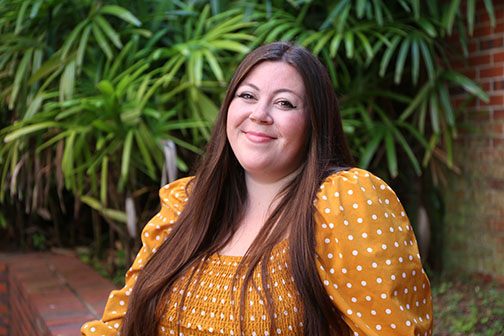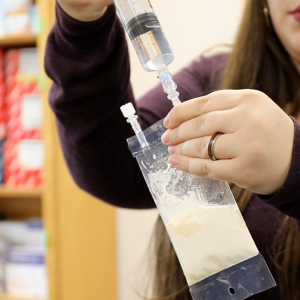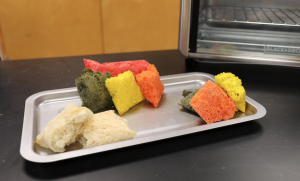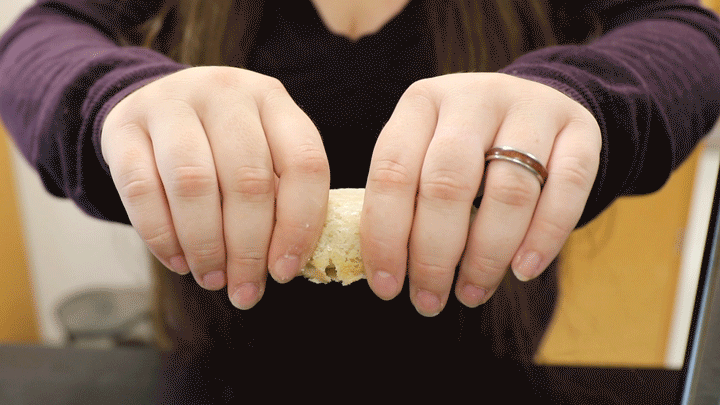GAINESVILLE, Fla. — Hope Hersh has her sights set on something out of this world—freshly baked bread for astronauts.

As a plant molecular and cellular biology doctoral student in the UF/IFAS College of Agricultural and Life Sciences, Hersh wanted to help solve problems that astronauts encounter in space. When submissions were requested for the Deep Space Food Challenge, hosted by NASA and the Canadian Space Agency, Hersh led a team that devised a way for astronauts to have freshly baked bread on their space expeditions.
“Team Space Bread,” as Hersh deemed the group, joined other students, chefs, small businesses and others in the competition. They were tasked with designing food production technologies or systems to help feed astronauts in deep space exploration. The designs would need to use minimal resources, yield minimal waste, and produce safe and nutritious food.
After a ten-month long process, Team Space Bread was one of 18 U.S. teams move on to the next step in the competition. Each team received $25,000 and the option to continue developing their technology in Phase II.
The bread bag
To successfully bake bread in space, Team Space Bread first focused on a bag that could store the bread-making ingredients, mix them, allow the dough to rise and finally bake in the oven. They settled on bags made of a fluorinated ethylene propylene, or FEP.
The idea of using FEP bags came from seeing them used during blood donation, said Mark Settles, who served as Hersh’s doctoral adviser at the beginning of her program.
“I saw [the phlebotomist] collecting the blood product in an FEP-type bag. The bags have oxygen permeation and let the blood stay alive,” Settles said.

This technology could be adapted to hold dough instead.
“The specially-designed FEP bags can withstand extremely high temperatures as well as extremely low temperatures, and they do not break down,” Hersh said. “This means no chemicals or biological reagents will get into the bread.”
Team Space Bread proposed filling the bags with all the dry ingredients on Earth. The wheat flour, yeast and salt would then be injected with water when the astronauts are in space. The space baker could then massage the bag to mix the dough and leave it to rise.
Finally, the entire bread bag could be placed into the oven to bake. Once it was fully baked, the astronaut would cut open the bag, removing a ready-to-eat loaf.
A “crumb-y” situation
The second component needed to successfully create bread for space missions was a crumb-less recipe.
“Crumbs are really bad for space exploration,” Hersh said. On Earth, crumbs just fall on a table or floor, but without gravity in space, crumbs float around and can get into equipment in the spacecraft.
John Young, an astronaut on NASA’s Gemini 3, famously snuck a corned beef sandwich on his space mission. He was only able to take a bite before it started breaking up and he stuck it back in his pocket. The crumbs were left floating around the cabin as the sandwich started to break apart.
This did not deter Team Space Bread from finding a way to make their bread work.
“The ‘New York Times’ actually has a bread recipe that was fairly easy,” Settles said. They started with that recipe and modified it until they had a freshly baked loaf that didn’t crumble apart when consumed.
“The dough looks a little liquid-y when you mix it,” Hersh said. “But in 12 hours, you have a dough that is beautiful, risen well, and is ready to go in the oven.”
A new(tritional) hope
The Deep Space Food Challenge also asked for designs that were nutritious.

“Sending fresh fruits and vegetables to space costs a lot of money,” Hersh said. “So it’s a rare treat for astronauts to have something fresh.”
To help the bread be more nutritious, Hersh’s team used a few extra ingredients.
“We can use bio-fortified yeast strains, or edible algae, inside the bread,” Hersh said. “Bio-fortified yeast strains produce chemicals called carotenoids. These carotenoids are also known as some of the most well-known vitamins, such as Vitamin A or beta-carotene.”
Bread baked with carotenoids adds color to each loaf. The carotenoids Hersh used produced vibrant orange, yellow and red loaves. The team also mixed edible algae directly into the bread to create a green loaf with additional nutrients for the astronauts.
“When you are in space, these vitamins are not as easily accessible as they are on Earth,” Hersh said. “We tried to make a delicious way for the astronauts to consume the vitamins to keep them healthy during their exploration.”
To infinity and beyond
For Hersh, who plans to graduate in 2022, winning the Deep Space Food Challenge is not the end goal. When she was younger, she had dreams of becoming a doctor or an astronaut. Now, while earning her doctorate, her ambition is to help the people who do travel into space be successful.

“I’m using the money to re-invest into the project. I’m taking my idea to Phase II because I already know my proof of concept works,” Hersh said. “And I want to see astronauts bake bread!”
-30-
The College of Agricultural and Life Sciences (CALS) administers the degree programs of the University of Florida’s Institute of Food and Agricultural Sciences (UF/IFAS). The mission of the College of Agricultural and Life Sciences is to deliver unsurpassed educational programs that prepare students to address the world’s critical challenges related to agriculture, food systems, human wellbeing, natural resources and sustainable communities. The college has received more total (national and regional combined) USDA teaching awards than any other institution.
 0
0
